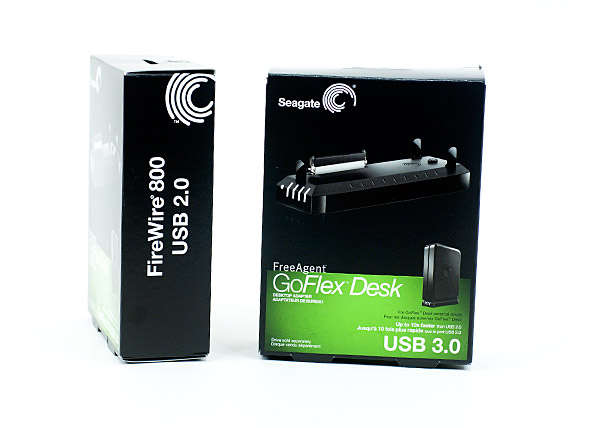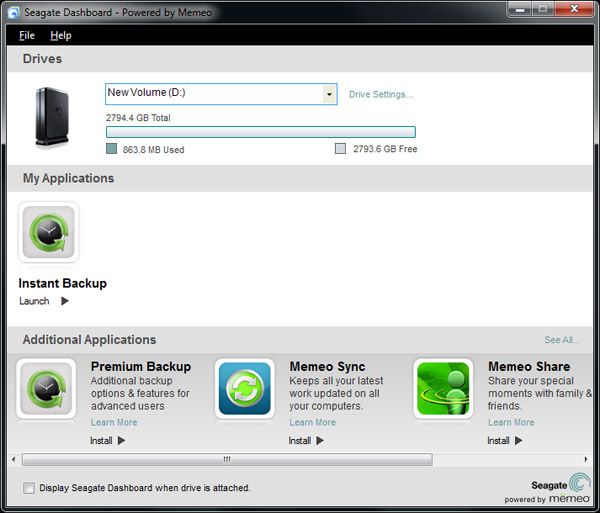The World's First 3TB HDD: Seagate GoFlex Desk 3TB Review
by Anand Lal Shimpi on August 23, 2010 12:39 AM EST- Posted in
- Storage
- Seagate
- HDDs
- GoFlex Desk
The GoFlex Desk
After putting the drive back together I decided to look at the product for what it is: an external 3.5” drive enclosure.
Seagate does nothing to hide the fact that this is a standard SATA drive in an enclosure. The SATA data and power connectors are clearly visible on the base of the enclosure. While you can plug a SATA power cable directly into the drive, the enclosure prevents you from sticking a SATA data cable in there - not without trimming away part of the plastic surrounding the cable’s SATA connector at least.

To mount the GoFlex Desk drive you just line it up with the dock and push down - the drive snaps into place. With a driver installed the dock can display how much of the drive is in use via a set of LEDs. These can be turned off in software.
The GoFlex Desk 3TB kit comes with a USB 2.0 dock ($350). You can buy the drive itself (in its GoFlex Desk enclosure) for $320.

The docks aren’t cheap, the basic USB 2.0 dock will set you back $30, while the USB 3.0 and FireWire 800/USB 2.0 docks are $40 and $50 respectively. And of course Seagate doesn’t make a dock with all three connections, the closest you can get is the FireWire 800 dock which has a USB 2.0 port on it as well.

The docks all use the same AC adapter. Power consumption at idle is around 10W, and the highest I saw under load was 14.3W.
There’s a fairly high performance 3.5” drive contained within so it’s not silent. I measured sound pressure in a room that measured 39.6 dB(A) with everything off:
| Sound Comparison | |||||
| Measured 1" Away | Measured 5" Away | ||||
| Off | 39.4 dB(A) | 39.4 dB(A) | |||
| Idle | 46.0 dB(A) | 40.7 dB(A) | |||
| Random Writes | 49.0 dB(A) | 41.0 dB(A) | |||
If you’re using a well designed notebook with its fans spun down, the GoFlex Desk is audible. If you’ve got another desktop or something else running in your room, you won’t notice the drive.
The drive ships with three pieces of software on it: Seagate’s Dashboard, Memeo Backup and Trial software, and a Mac OS X NTFS driver.

The Dashboard gives you basic info about your drive. You can control the LED lights on the GoFlex Desk dock - either keep them on or turn them all off.

The Memeo Instant Backup software is pretty basic. When configured it runs in the background and will automatically backup all non-system or program files. In other words it copies your documents, pictures, music and downloads but it won’t back up your OS, logs, or installed applications.

The backup happens automatically whenever files are saved/added. There’s a CPU usage penalty when this happens of course. Memeo Instant Backup uses around 11% of my quad-core Core i7 975 while backing up on the fly. It’s not an issue on a high end system, but lower end and single core machines for sure will have issues with the auto backup.
The final piece of software is nice for users who have both Macs and PCs. By default Macs can’t write to NTFS formatted volumes - they are read only under OS X. Seagate ships Paragon NTFS for Mac OS X v8.0.0 with the GoFlex Desk, normally $40, for free. Paragon NTFS lets you write to NTFS partitions as seamlessly as you’d write to a HFS+ partition in OS X. Just install the driver, reboot, activate, reboot once more and you’re good to go. There’s no performance impact vs. writing to HFS+ partitions.

You can also apparently activate it on multiple computers, so you can use it if you’ve got a Mac/PC household with multiple Macs.










81 Comments
View All Comments
Belard - Monday, August 23, 2010 - link
ALL brands have their bad batches. Maxtor, WD, Hitachi-IBM, etc... and even intel.I have used lots of Seagates and Maxtors with good reliability. Yes, I've had failures - but not really any more than WD.
In the OLD days, Seagates were called "Sea-crates" typically used in cheap PCs ($2000+ computers) - I'd never touch those junky RLL drives. I bought Quantum SCSI drives which were higher end, more reliable and costs more money... and being SCSI - they were much faster. I miss Quantum. :( Today, I buy Seagates - they are easily quieter than most drives - with only Samsung just as quiet.
I still buy 1TB Seagates. I don't trust the 1.5~2TB drives from anyone. But the tech used in 2~3TB drives are filtered down to the 500GB drives (single 500GB platter) - so the density reliability issue is there - but the less-parts (heads and arms) factor does help. So todays 500GB drives are very thin... wow! ;)
mewgirl - Monday, January 31, 2011 - link
....But since WD is THE WORST manufacturer of external hard drives, this post means you are definitely NOT recommending Seagate, then, correct?mino - Monday, August 23, 2010 - link
You should NEVER use an on-demand cooling system with magnetic storage.Hard disks are an order of magnitude more sensitive to temperature changes than pure high temperatures.
Jonathan Dum - Monday, August 23, 2010 - link
Interesting. Proof to back up that claim?has407 - Monday, August 23, 2010 - link
The OP is nominally correct. While I wouldn't go so far as to say "NEVER use an on-demand cooling system", I'd say they're likely to do more harm than good unless carefully engineered and integrated with the HDD.Rapid changes in temperature can kill a drive faster than elevated temps due to, e.g., thermal expansion/contraction of components (heads, platters, spindles, etc.), and air density changes which affect head ride height.
Those changes require active adjustment and compensation, and are necessary and common in today's drives/controllers. However, there are limits. Drive manufacturers specify a maximum temp change/time (even if it may not show in the data sheets available on their web site).
The best solution is to maintain a steady and moderate temperature change. The worst solution is a typical/cheap "bang-bang" controller that starts/stops when temperature limts are reached, and which causes rapid changes in the drive's temperature.
Case in point: The absolute worst thing you can do for your laptop drive after leaving it in the car for hours on a frigid day is drag it into a warm room and immediately start pounding on it. Virtually guaranteed to result in errors and reduced life (if not short-term failure).*
In short, active cooling is not necessarily bad, but stupid active cooling that causes wide temp swings over short periods in the drive can cause far worse problems than allowing the drive to run at an elevated and slowly changing temp.
This has been a problem for many years, and increasingly as tolerances decrease (especially with higher track densities). While drives/controllers continue to adapt and improve, it's still a significant factor, and the larger the media the worse the problem. For recent papers (sorry, don't have any recent freely available links), see:
http://scitation.aip.org/getabs/servlet/GetabsServ...
http://ieeexplore.ieee.org/Xplore/login.jsp?url=ht...
* Yes, people talk about the "freeze your HDD" to try and recover it. (It may even work--never tried it.) But subjecting an HDD to that kind of rapid temperature change abuse even occassionally is guaranteed to kill it in short order.
JonnyDough - Monday, August 23, 2010 - link
It makes a lot of sense, even without the links. The hardest thing on a car is starting it in the dead of winter when there's no oil up in the engine. It grinds, and then as the friction causes it heat up quickly with cold oil it continues grinding until it is warm and coated in oil internally.mindless1 - Monday, August 23, 2010 - link
That is wrong. If you have a constant speed/always-on cooling system, it means that the drive changes in temperature as it wakes up, reads and writes, and more as it keeps running.If you have on-demand, as the drive starts to warm the fan kicks in and keeps the drive at a more constant temperature, including increasing fan RPM as needed to keep the drive at the same temperature! Plus, with on-demand all those times you are not using the drive and it is sleeping and at low temperature, your fan isn't pulling in dust to clog up things.
Also, it IS high temperature that does damage. Granted, yes it has to change temperature to get to a high temp, but the more the temperature changes the more the different coefficients of expansion come into play. For example, you can stretch a rubber band all day long, but if you stretch it too far it starts to rip apart.
Belard - Monday, August 23, 2010 - link
This or anyone else... should have minded the heat problems. There are external cases for HDs that have an 80mm cooling fan - low RPM.My Seagate drives in my case (1TB) are currently 39c... I run my fan at LOW speed to keep the noise to pretty much silent. A drive hitting 50c+ would make me nervous... 60+ is VERY bad!
And for a 3TB drive holding that much data, RELIABILITY is most important! USB 3.0 and such are important features when moving that much data and it'll slow down when you're using the drive for what it is intended?!
BAD BAD BAD
The dock is a handy, but a wider one would be nicer... there are other dock-drive designs out there, some with dual docks. Generic versions that allows you to put in ANY drive would be the way to go. OR better yet... use the HOT-SWAP abilities of eSATA and pop your drive into a drive bay on your computer - NO DOCK NEEDED!
Theres about 60+ options on Newegg. Many docks, you just plug in your drive - sans case.
Aikouka - Monday, August 23, 2010 - link
Heat problems are one of the reasons why I'm starting to shy away from Seagate drives after using them for a few years. A few months ago, I noticed that one of my WD 1TB HDDs was exhibiting some odd file read issues. When I opened up my server, I found it right above a Seagate 1TB HDD, and when I tried to pull the Seagate drive out, it was almost too hot to touch!Of course a (mechanical) hard drive will produce heat, but the Seagate seemed to be in a league of its own compared to all the other drives in my file server. I'm really not sure what brand to even go with now... I purchased a Samsung drive based on recommendations, and that drive died after only two months (the whole random disappearing act leading to refusing to ever show up). I recently purchased a WD 2TB drive that came up clean in a full-disk error check, so we'll see how that goes!
mindless1 - Monday, August 23, 2010 - link
Your server is not set up correctly, blame it not the drive. A proper case configuration for stacked drives leaves at least 1cm or so between each and ample cool intake airflow through the drive rack. In that scenario you will have no problem cooling any 7200 RPM drive, or with higher airflow rate, 10K RPM drives too.Also, there is not a significant difference in operating power or running temp of equivalent drives from Seagate vs other brands. Single-digit # of degrees is not enough to matter one way or the other till you reach the upper limits.